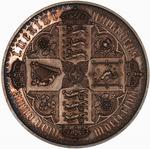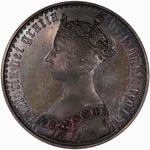|
First issued in 1847, William Wyon RA’s Gothic Crown is one of the most beautiful coins ever struck by The Royal Mint. Inspired in part by the Scottish artist William Dyce RA, the obverse and reverse designs are works of genius, produced by the engraver William Wyon at the very peak of his creative career. Coveted by Victorian numismatists and mostly collected straight from the Bank of England, only 8,000 silver along with a handful of gold coins were struck.
While this is not a rare coin, its glamorous design makes this coin always in demand. The type was also issued in 1853 as a proof only. This design was never struck for circulation, but was reused on the Gothic Florin between 1848 and 1887. |
|
|
| Obverse | |
|---|

Within a decorated border, the obverse of the coin shows the young crowned bust of Queen Victoria, facing left; the effigy is by William Wyon and is widely known as her "Gothic Portrait".
The Queen's hair is braided and held back in a bun, with a braid looping around her ear. Her dress is decorated with rose, thistle and shamrock - the national plants of the constituent nations of the United Kingdom (England, Scotland and Ireland respectively).
Around, the monarch's legend: Victoria d: g: brit: reg: f: d: - abbreviated from Victoria dei gratia britanniarum regina, fidei defensor; translated from Latin, Victoria, by the Grace of God, Queen, Defender of the Faith. The lettering is in ornate Gothic script, giving the coin its popular name, the Gothic Crown. |
|
|
| Reverse | |
|---|

Within a decorated border, the reverse design represents the three nations brought together by the Act of Union in 1801 and depicts a crowned cruciform (in a cross pattern) shields bearing the three lions passant of England (twice, in positions 1 and 3), the lion rampant of Scotland (2), and the harp of Ireland (4). The shields are contained within a deeply tressured circular panel. In the angles are two roses, a shamrock and a thistle - the national plants of England, Scotland and Ireland respectively. In the centre there is a four-leafed flower.
At centre, a small flag of the Union (commonly known as The Union Jack), surrounded by the Order of the Garter inscribed with its motto HONI SOIT QUI MAL Y PENSE (translated from Old French: May he be shamed who thinks badly of it).
Around above, interrupted by St Edward's crown on top of the English shield, the inscription tueatur unita deus - May God guard these United (Kingdoms). Around below, also interrupted by the crown, the date of issue in Latin: anno dom mdcccxlvii - abbreviated from Anno domini MDCCCXLVII - Year of Our Lord 1847. As on the obverse, all the lettering is in ornate Gothic style. |
|
| Reverse Inscription |
tueatur unita deus anno dom mdcccxlvii |
|---|
|
| Edge | Inscribed (raised lettering) | Edge Inscription | Decus et tutamen. anno regni undecimo. |
|
| Notes | The edge lettering Decus et tutamen. anno regni undecimo. means "an ornament and a safeguard" (referring to the role of the edge as protection against clipping of the coin), regnal year eleventh.
William Wyon is widely regarded as one of history’s great coin designers. Born in Birmingham, England in 1795, he took the position of Assistant Engraver at The Royal Mint in 1816. His career flourished and in 1828 he was appointed Chief Engraver. His reputation is forever linked to the reign of Queen Victoria, producing portraits which followed her journey from a 13-year-old princess to a dignified head of state, including the Neo-Gothic portrait that graces the obverse of the 1847 Crown.
Reverse designer William Dyce, primarily a painter, was one of the forefathers of art education. In 1837 he moved from Edinburgh, where he was in charge of the School of Design, to London to become head of the new Government School of Design, which later became the Royal College of Art. In 1844 he was appointed Professor of Fine Art at King’s College London, before collaborating with William Wyon on what is now recognised as one of the most artistically significant coins of the 19th Century; the "Gothic Crown". |
|---|
|









 Search for United Kingdom: Crown 1847 Gothic on eBay
Search for United Kingdom: Crown 1847 Gothic on eBay 